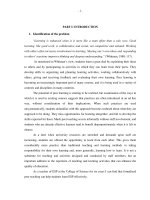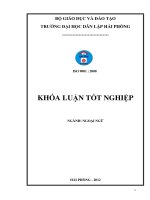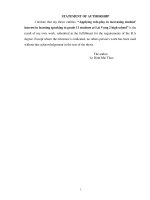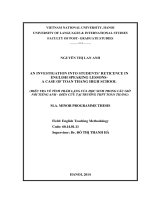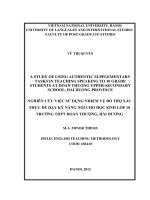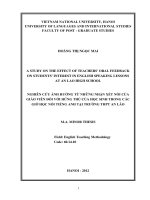Dealing with reticence in English speaking activities of non-English-majored students at University of Science, Vietnam National University Hanoi
Bạn đang xem bản rút gọn của tài liệu. Xem và tải ngay bản đầy đủ của tài liệu tại đây (1.4 MB, 77 trang )
VIETNAM NATIONAL UNIVERSITY, HANOI
UNIVERSITY OF LANGUAGES AND INTERNATIONAL STUDIES
FACULTY OF POST- GRADUATE STUDIES
-----------o0o------------
NGUY N VŨ XUÂN LAN
DEALING WITH RETICENCE IN ENGLISH SPEAKING
ACTIVITIES OF NON-ENGLISH-MAJORED STUDENTS
AT UNIVERSITY OF SCIENCE,
VIETNAM NATIONAL UNIVERSITY HANOI
KH C PH C TÌNH TR NG KHÔNG NHI T TÌNH THAM GIA CÁC
HO T Đ NG NÓI MÔN TI NG ANH C A SINH VIÊN KHÔNG
CHUYÊN TRƯ NG Đ I H C T
NHIÊN,
Đ I H C QU C GIA HÀ N I
M.A. MINOR PROGRAMME THESIS
Field: English Teaching Methodology
Code : 60140111
Hanoi, 2016
VIETNAM NATIONAL UNIVERSITY, HANOI
UNIVERSITY OF LANGUAGES AND INTERNATIONAL STUDIES
FACULTY OF POST- GRADUATE STUDIES
-----------o0o------------
NGUY N VŨ XUÂN LAN
DEALING WITH RETICENCE IN ENGLISH SPEAKING
ACTIVITIES OF NON-ENGLISH-MAJORED STUDENTS
AT UNIVERSITY OF SCIENCE,
VIETNAM NATIONAL UNIVERSITY HANOI
KH C PH C TÌNH TR NG KHÔNG NHI T TÌNH THAM GIA CÁC
HO T Đ NG NÓI MÔN TI NG ANH C A SINH VIÊN KHÔNG
CHUYÊN TRƯ NG Đ I H C T
NHIÊN,
Đ I H C QU C GIA HÀ N I
M.A. MINOR PROGRAMME THESIS
Field: English Teaching Methodology
Code : 60140111
upervisor
r Ho ng Th Xu n Ho
Hanoi, 2016
DECLARATION
I hereby certify that this research entitled “Dealing with reticence in English
speaking activities of non-English-majored students at University of Science,
Vietnam National University, Hanoi” was conducted and then submitted in partial
fulfillment of the requirements for the degree of Master of Arts (M.A). This paper
was original and has not been submitted for any degrees at any other universities or
institutions.
Hanoi , 2016
Ngu n V Xu n L n
i
ACKNOWLEDGEMENTS
First of all, I would like to express my deepest appreciation to Dr. Hoang Thi
Xuan Hoa for her expert guidance, encouragement and patience during my
completion of this MA thesis. Her important suggestions greatly contributed to the
final improvements of this paper.
Special thanks should also be sent to colleagues and my students at Hanoi
University of Science, without whom the data procedures could not have ever been
completed.
Finally, I take this opportunity to record my sincere gratitude to my family,
for their incessant support, without which I would not be able to overcome personal
difficulties to complete this paper on schedule.
ii
ABSTRACT
Reticence has been a common problem in EFL classrooms, which seriously
damages students’ studying process as well as restricts academic improvement of
the whole class. This paper reports an action research undertaken in an English
course for 24 second-year non-English majors in a university in Hanoi, Vietnam.
Employing such research instruments as questionnaires, researcher’s
classroom observation and students’ reflection, the study reveals that these students
had low current level of reticence which was presumably caused by some certain
factors. With the aim of decreasing students’ reticence in speaking activities,
various measurements including brainstorming strategies training, communication
strategies training and motivational feedback were applied. Data collected after the
research project proved the positive influence of these measurements on students’
willingness to participate in speaking activities in class.
iii
TABLE OF CONTENTS
Declaration .............................................................................................................. i
Acknowledgements ............................................................................................... ii
Abstract ................................................................................................................. iii
Table of contents .......................................................................................... iv
Abbreviations ........................................................................................................ vi
List of tables and figures ...................................................................................... viii
PART A. INTRODUCTION
1. Problem statement and rationale of the study ....................................................... 1
2. Aims and objectives of the study ....................................................................... 3
3. Research questions ............................................................................................ 3
4. Scope of the study ............................................................................................... 3
5. Methods of the study .......................................................................................... 4
6. Design of the study .............................................................................................. 4
PART B. DEVELOPMENT
CHAPTER 1. LITERATURE REVIEW
1. Speaking skills .................................................................................................... 5
2. Reticence ............................................................................................................. 6
2.1. Definitions of reticence ................................................................................... 6
2.2. Reticence in classroom .................................................................................... 7
2.3. Causes of reticence in EFL classroom ............................................................... 8
2.4. Foreign Language Class Anxiety Scale (FLCAS) ........................................... 19
2.5. Possible solutions for reticence in EFL class .................................................. 19
3. Related studies................................................................................................... 15
CHAPTER 2. METHODOLOGY
1. Background of the study .................................................................................... 17
1.1 Description of the English course and textbook .............................................. 17
1.2. Participants .................................................................................................... 17
2. Action research ................................................................................................. 18
iv
2.1. Rationale for action research .......................................................................... 18
2.2. Action research model ................................................................................... 20
3. Research instruments ........................................................................................ 21
3.1. Questionnaire ................................................................................................ 21
3.2. Classroom observation ................................................................................... 22
3.3. Reflective report ............................................................................................ 22
4. Research procedure ........................................................................................... 23
4.1. Research steps ............................................................................................... 23
4.2. Data analysis ................................................................................................. 24
4.3. Procedure of the intervention ......................................................................... 24
CHAPTER 3. RESULTS AND DISCUSSION
1. Research question 1 ........................................................................................... 29
2. Research question 2 .......................................................................................... 35
PART C. CONCLUSIONS
1. Summary of the major findings of the research ................................................. 43
2. Teaching implication ........................................................................................ 45
3. Limitations of the study .................................................................................... 46
4. Suggestion for the next cycle ............................................................................ 47
REFERENCES ...................................................................................................... 48
APPENDICES......................................................................................................... I
v
ABBREVIATIONS
List of abbreviations
EFL: English as a foreign language
FLCAS: Foreign Language Class Anxiety Scale
vi
LIST OF TABLES AND FIGURES
List of tables
Table 1. Comparison between traditional research and action research ................. 19
Table 2. Timeline of intervention phase ................................................................ 25
Table 3. Excerpt from table of score for students’ activeness in pair work and group
work ...................................................................................................................... 38
List of figures
Figure 1. Waters-Adams’s action research model (2006) ...................................... 20
Figure 2. Average score of each categories of FLCAS .......................................... 35
Figure 3. Class’s average score of activeness in group and pair speaking activities in
each period ........................................................................................................... 38
vii
PART A. INTRODUCTION
This part, which is an introduction to the thesis, helps to provide the
background as well as the context for the present study. The section includes the
statement of the problem and rationale for the study, research questions, aims and
objectives, significance, scope of the study and an overview of the rest of the paper.
1. Problem statement and rationale of the study
According to researchers in foreign language teaching, speaking skill is
believed to be a significant component of any language teaching curriculum. The
ability to speak/ communicate in English is one of the initial aims of learning and
using a foreign language (Tsui, 1992; Ellis, 1988).
The importance of speaking skill can be seen in two aspects: in social and in
academic context. Firstly, being able to communicate, which also reflexes the
speaker’s self-expression, personality, reasons and thoughts in a variety of social
and working situations, is surely the goal of almost every L2 learners (Luoma,
2004). Secondly, there is an undeniable connection between students' classroom
participation and their academic achievement. Students who participate actively in
class, in other words, more willing to speak out in class, are proved to have higher
academic achievement than that of those who are passive in class. KrupaKwiatkowski (1998), in her study, claims that "interaction involves participation,
personal engagement, and the taking of initiative in some way, activities that in turn
are hypothesized to trigger cognitive processes conducive to language learning" (p.
133). This also implies that whether students can perform well in foreign language
partly relies on their behavior and activeness in class. The more they are
enthusiastic in speaking lessons, the more likely that they will learn effectively.
Consequently, the role of the ability to speak, as well as the perception of ability to
speak, should not be underestimated by either teacher or pupil.
In real teaching situation, however, a great number of students show low
level of in-class participation. They are normally not willing to speak English or to
join in speaking activities with classmates; even when they know the answers, they
1
hesitate to speak up. It is assumed that when people speak in a second or foreign
language, they become more apprehensive and tense and thus more unwilling to
participate in conversation (Horwitz et al., 1986). Researches carried out with
interviews, observations, journals and survey revealed that a large proportion of L2
learners have the tendency to stay passive and reticent in foreign language
classrooms, which hinders their academic achievement. Encouraging students to
talk in a language classroom, therefore, is a problem that most language teachers
face (Tsui, 1996). With the importance of speaking as mentioned above, there is a
pressing need for English as Foreign Language (EFL) teachers to help reticent
students develop the skills and confidence needed to take an active role in oral
classroom lessons. Thus, researchers have been paying increasing attention to the
growing importance of oral proficiency in L2 learning situations (Chen, 2003;
Flowerdew et al., 2000; Jackson, 2002, 2003; MacIntyre et al., 2001; Tong, 2010).
Most of these studies focus on the factors accounting for this phenomenon.
As an EFL teacher in Vietnam, the researcher has experienced many difficult
groups of students who have low proficiency in speaking but refuse to collaborate in
class. In Asian culture context, this has been shown more clearly than ever. The
majority of Vietnamese students have 3 to 12 years studying English from primary
school to high school; nevertheless, English subject is usually test-oriented, hence
focuses mainly on grammar and reading while speaking is generally neglected.
Students have very few chances for oral practice, which lead to the deficiency on
speaking skill and also the habit of speaking in foreign language. As a consequence,
students bring that passive habit along when entering university, creating highly
inactive atmosphere when it comes to speaking activities. It has become common
that a student graduating from university with 2 years of learning English cannot
hold a simple conversation with foreigners. In the advent of globalization, an
increasing number of companies require certain English level or certification from
their employees; meanwhile, the number of university and college graduates who
are incapable of using English has always been alarming. This prevents them from
2
pursuing their desired career or looking for opportunities to work or study abroad.
Accordingly, the researcher feels the urge to find out the reasons for the silence of
students in speaking class and experiment various solutions to help them gain
confidence as well as take their chances to learn and practice English.
Another reason for carrying out this study is the fact that willingness to participate
in class has been found to vary according to the context (Liu & Jackson, 2009). Since not
so many studies have previously dealt with confidence in a Vietnam L2 context, this paper
is an attempt to contribute to knowledge in the field of L2 teaching, taking the issue of
reticence into account in a Vietnamese EFL classroom.
2. Aims and objectives of the study
This action research project was conducted to aim at solving the problem of
reticence in speaking activities which possibly caused students’ low achievement in
English subject at university.
The specific objectives which guide the study as outlined as follows:
1) To identify the given class’s current level of reticence and possible causes;
2) To evaluate the impact of the intervention on the students’ reticence level.
3. Research questions
This paper is expected to answer these following questions:
1) What was the level of reticence in English speaking activities of students before
the research project?
2) To what extent was reticence changed after the intervention as perceived by
teacher and by students?
4. Scope of the study
This research was carried out in the school year 2016 – 2017, in a class of 24
students at University of Science, Vietnam National University, Hanoi during a
course of 6 weeks (from August to October), which is equal to half of a semester.
These students were at pre-intermediate level, and had studied English for two
semesters before that. The course book employed was New English Files
Intermediate (Oxeden, 2007). Since the teacher/ researcher’s major concern is
3
reticence in speaking activities, this study concentrates on activities that involve/
require speaking skills only. Among many research approaches, this study employs
action research as the main approach to collect and analyze data.
5. Methods of the study
As mentioned in the previous part, the researcher chose action research for
this study for several reasons. Unlike other types, action research is considered
"practical research" since the matter of the research is rooted from real situations,
real problems identified by researchers, and it proposes measurements to solve
those problems or improve the situations. Brown (2005, as cited in Songsiri, 2007,
p.50) agreed that action research does not only benefit learners but also aids
teachers in enhancing their teaching effectiveness. This study employed such tools
as questionnaire, observation and reflective report for each stage of the study.
6. Organization of the study
The study is divided into five chapters:
Part A: Introduction
Part B: Development
Chapter 1: Literature Review
This chapter reviews the current theories on reticence. To be specific, definition,
possible causes and solutions proposed by previous studies will be mentioned.
Chapter 2: Methodology
The Methodology chapter explains why action research was chosen as the research
method, shows the steps of how the research was conducted, and justifies data
collection instruments and data analysis methods.
Chapter 3: Findings and Discussion
In chapter 3, the actions, findings and analysis of the findings of the research are
provided in response to the research questions.
Part C. Conclusion
This part summarizes the findings of the action research, acknowledges the
limitations and offers suggestions for further research.
4
PART B. DEVELOPMENT
CHAPTER 1. LITERATURE REVIEW
1. Speaking skills
Among four skills in English learning, speaking and writing are categorized
into productive group. Speaking is the bridge to reach other skills, helps learners to
read better, to listen more effectively and to write more accurately. Speaking is
surely the most effective means of communication (Ur, 1996)
There are two important reasons why speaking should be taught in
classroom. First, speaking is considered “a survival skill in real life” (Ur, 1996,
p.134). In this era of globalization when English has been regarded as the
international language, it is essential for any individual who desires to interact with
the surrounding world to be able to speak this language. Speaking aids learners to
develop not only socially but also academically since it is an indispensable tool for
thinking and learning. Secondly, the ability to speak English is a good source of
motivation for learners. The mastery of speaking skills in English is a priority for
many second or foreign language learners. Richards (2009) pointed out “learners
consequently often evaluate their success in language learning as well as the
effectiveness of their English course on the basis of how well they fell they have
improved in their spoken language proficiency” (p.21). Nunan (1991) agreed with
this point of view, claiming that success is measured in terms of the ability to carry
out a conversation in the target language. It can be concluded that a lot of language
learners correlate their proficiency in speaking with their overall ability in the target
language, which means that if they are able to speak well, they are more likely to be
confident and motivated in studying the language. These are the reasons for which
speaking skills are hardly neglected in language classroom.
5
Common problems in EFL speaking class:
There are several discussions about problems that come from body of the
students their self. The problems are commonly become obstacles in teaching
speaking. Some major problems, according to Brown (2000) and Harmer (2007),
are native language, age, exposure, motivation and concern for good speaking.
Other specific problems that are commonly observed in the language
classroom are related to individual learners’ personalities and attitudes to the
learning process and learning speaking in particular. They can be defined as follows
inhibition (fear of making mistakes, losing face, criticism; shyness), lack of things
to say (learners have problems with finding motives to speak, formulating opinions
or relevant comments), low or uneven participation (often caused by the tendency of
some learners to dominate in the group), mother-tongue use (learners find it easier
or more natural to express themselves in their native language) (Ur 1995, 121). As
many teachers’ observations indicate, the above situations occur in language
classrooms regardless of the level of proficiency or the number of students in the
group. It seems that all of these phenomena share a relation with reticence of
students in speaking activities. This is to say that reticence, with its expressions
such as inhibition, lack of things to say or low participation, is one of the problems
that need to be addressed since it impedes the process of teaching and learning in
speaking classroom.
2. Reticence:
2.1. Definitions of reticence:
The major characteristic of a reticent person is avoidance of social situations
in which they feel inept (Phillips, 1997). Phillips (1984) stated: “when people avoid
communication because they feel they would lose more by talking rather than by
remaining silent, we refer to it as reticence” (p.52).
Keaton and Kelly (1999) redefined reticence basing on Phillip’s theory as
follow: When people tend to avoid communication because they believe it is better
to remain silent than to risk appearing foolish, this behavior is referred to as
6
reticence. Reticent individuals are those who tend to avoid communication due to
the threat of negative evaluation. Keaton and Kelly (1999) also asserted that
reticence, as a behavioral response, is not always problematic in social
communication. However, it does become problematic when chronic silence
prevents an individual from obtaining his or her personal or professional goals.
2.2. Reticence in classroom
Student’s lack of activeness in class is a common problem that has been
experienced by a great number of language teachers, especially those who work
with Asian students. Some demonstrations of students’ reticence are their
withdrawal, or fear of interacting with teachers and peers, silence in group
discussion and hesitation/ refusal when answering direct questions.
Reticence, to some degree, is a strong indicator of academic performance.
Reticence has been proved to have a detrimental effect on students’ confidence,
self-esteem and level of participation. Reticent learners suffer from mental blocks
during spontaneous speaking activities, lack confidence, are less able to self-edit
and identify language errors and are more likely to employ strategies such as
skipping class (Liu, 2011). Anxious students are also more likely to forget
previously learned material, volunteer answers less frequently and have a greater
tendency to remain passive in classroom activities than their less reticent
counterparts.
Moreover, reticence is not just a problem for individuals themselves. By not
sharing what they know, those silent students deprive their classmates of
opportunities to benefit from their knowledge, insights, and thinking (Liu, 2011). In
a classroom environment, one’s contributions stimulate more and better thinking
from others; everyone in a classroom needs to participate – by discussing and by
listening to others. All students are benefit from idea and perception sharing.
Consequently, students’ reticence is destructive for teaching and learning process.
Therefore, the reticent problem deserves to be seriously studied and solutions are
expected by all who are concerned with teaching and learning.
7
2.3. Causes of reticence in EFL classroom:
Reticence in English classroom is often considered to correlate with foreign
language anxiety. The anxiety here stands for the feeling of uneasiness, worry,
nervousness and apprehension experienced by non-native speakers when learning or
using a second or foreign language. Nevertheless, anxiety is only one among many
other factors causing unwillingness to speak up of learners.
Different researchers have employed different ways of identifying students’
reasons of reticence. Using interviews, observations, and journals written by
second/foreign language learners, researchers have managed to discover why some
language learners choose to remain silent in language classrooms (Dwyer and
Heller-Murphy, 1996; Flowerdew and Miller, 2000; Liu, 2005; Donald, 2010;
Riasati, 2014). These causes can be summarized as follow:
(1) low self-esteem: students who think of themselves as unable to communicate
successfully, so they tend to remain silent out of shame;
(2) fear of negative evaluation when they give inaccurate response;
(3) fear of success: this seemingly strange phenomenon occurs when a student
interacts successfully; they consider their success as luck or coincidence and then is
afraid that others expecting them to continue excellent performance in the future,
which they cannot guarantee.
(4) communication apprehension – a fear of communicating with or in the presence
of others.
(5) low proficiency in the target language: students do not have enough vocabulary,
grammar structures and knowledge about rules and norms in English conversation
to produce their speech, and/ or they lack subject matter, which means students have
nothing to speak on a particular topic
(6) external factors: unfamiliar environment, teacher’ teaching style, and
incomprehensible input and lack of familiarity with the tasks.
8
2.4. Foreign Language Class Anxiety Scale (FLCAS)
In attempt to establish a valid and reliable anxiety measure specific to
foreign language learning, Horwits (1986) and colleagues developed an instrument
called FLCAS to measure the level of learners’ anxiety. In their conception,
language learning anxiety, can be subcategorized into three distinct forms of
performance anxieties namely communication apprehension, test anxiety and fear of
negative evaluation.
Anxiety has been shown to be one of the major causes for reticence in
language class in previous studies (Dwyer and Heller-Murphy, 1996; Liu, 2005;
Donald, 2010). High level of anxiety is equivalent to high level of reticence.
Consequently, the teacher/ researcher found FLCAS a reliable tool to identify
students’ reticence.
The original FLCAS questionnaire consists of 33 items which can be divided
into 3 categories (Communication Apprehension, Test Anxiety and Fear of
Negative Evaluation). Among items of each category, there are positively keyed and
negatively keyed ones. However, all of these items are presented randomly in the
survey without the three category names.
Basing on the causes of reticence in language class identified by previous
studies and on Liu (2009) adapted questionnaire, some items are precluded or
reworded and some others are added to better reflex the situation in the teacher/
researcher’s English classroom and the categories are rearranged. The complete
questionnaire used in this study can be seen in Appendix 1.
2.5. Possible solutions for reticence in EFL class:
2.5.1. Solutions for general reticence in EFL class:
There have been very few researches exploring the resolutions for the
problem of reticence in English class. Nguyen, H. (2010), Riasati (2014), Songsiri
(2007) have pointed out several techniques to encourage reticent students to speak
in classroom. Their proposed solutions have a lot in common and all agree on some
main points such as: the significant role of communicative language teaching (in
9
which communication strategies are emphasized), classroom atmosphere, group
work, students’ anxiety reduction and students’ attitude. Many of these techniques
are based on the Cognitive, Affective and Situational Framework put forth by
Nation (2007).
a. Reduce the level of task difficulty
From Nation (2007)’s point of view, if students do not know enough, they
will not be able to perform the task well, and this is one of the causes of students’
unwillingness to speak. Teachers can make tasks more accessible for students by (1)
giving students more time to do tasks, (2) bringing the tasks within students’
experience and (3)allowing students to collaboratively solve communicative tasks.
b. Promote positive attitudes among students
Students who have positive attitudes towards language learning are less
likely to suffer from language learning anxiety and more likely to participate
actively in learning tasks (Tsiplakides & Keramida, 2010). The following
techniques can help the teacher build up positive attitudes among students so that
they can feel free to speak in the language class. First, it is important to change
students’ negative beliefs and attitudes towards mistakes, let them know that
making errors is a part of learning; hence, meaning-focused oral activities should be
utilized. Secondly, students’ self-confidence can be boosted by creating various
opportunities for classroom success in using spoken English (Oxford, 1999). If easy
tasks, clear and simple goals are used in the first place and completed by students,
students can achieve sense of success and high self-perceived communication
competence more easily. Last, Young (1991) suggested that teacher can lower
students’ anxiety in the classroom by finding out what students are anxious about,
then helping them ease some of their fears and teach them strategies such as selftalks and doing relaxation activities to deal with fears.
c. Build a supportive learning environment
If students can feel a sense of support from their teacher and classmates, it is
more likely that they will be willing to speak in the target language. The following
10
are some techniques that teachers can use to create a supportive atmosphere for
students. First, teacher may encourage peer support in the classroom to help
students feel secure about their answers or performance later. Also, teachers are
suggested to be sensitive when assigning students into groups since causes for
reticence varies from student to student. Next, it is common that students at low
level are not yet able to convey all of their ideas. Therefore, they should be allowed
to use L1 when appropriate. Last, it is important to make the classroom environment
a non-threatening place by avoiding the following actions: correcting mistakes on
the spot, calling on students at random, calling on students without allowing them to
prepare for the answers, and calling on a student simply because he/she is quiet or
not concentrating (Young, 1991).
2.5.2. Possible solutions for reticence in speaking activities in EFL class
a. Communication strategies training
Speaking competence is constructed from two basic parts which are
linguistic competence and communicative competence. The former includes the
ability to pronounce correctly, a sufficient amount of vocabulary and mastery of
syntax in another language (Nunan, 1999). The other element, communicative
competence involves a range of sociolinguistics and conversational skills which
help speakers to know how to converse appropriately.
Any language course is sure to include knowledge about pronunciation,
vocabulary and grammar, which ensure the practice for linguistic competence.
However, when a student has not yet mastered the language, they need
communicative competence to make up for breakdown in communication due to
insufficient competence. The more students have communicative competence, the
greater confidence they have. In other words, communicative competence plays an
important role in motivating students to speak. Therefore communication strategies
will be used as a tool to increase students’ competence and activities are needed to
enable this. Oxford (in Nunan and Carter, 2001, p. vi) believed that:
11
Strategies are an important factor to develop communicative competence. Learners
developing appropriate learning strategies have greater self-confidence and learn more
effectively.
According to Bygate (1987), communication strategies include achievement
strategies and reduction strategies. The former involves attempting to compensate
for speaker’s language by improvising a substitute, while the latter means reducing
the message so as either to bring it within the scope of speaker’s knowledge or else
to abandon the message and go on with something the speaker can manage. In this
study, the aim is to encourage students to speak up in class instead of avoiding
communication problem; consequently, achievement strategies are preferred to be
applied. There are various types of achievement strategies that students may use,
including:
a.
Foreignizing a mother-tongue word: pronouncing it as though it belonged to
the target language. The teacher/ researcher finds this strategy impractical for
Vietnamese students as their mother-tongue share very few pronunciation rules in
common with English.
b.
Borrowing a word from mother-tongue: when lack vocabulary in the target
language, speaker may use L1 occasionally with the hope that the interlocutor will
get the message. This strategy is feasible in a language class where all students have
the same mother-tongue.
c.
Literally translating a mother-tongue word: for example, a Portuguese
speaker could try the word “feast” instead of “party” or “holiday”, based on “festa”.
However, this strategy also requires a certain vocabulary and similarity between
mother-tongue and target language.
d.
Coining a word: the speaker can invent a target-language word creatively on
the basis of his or her knowledge of the language. For example, “airball” can be
used instead of “balloon”.
12
e.
Paraphrasing: searching the speaker’s knowledge of the target-language
vocabulary to find an alternative to the expression that they need. The speaker can
look for a synonym or a more general word.
f.
Using body language: physically indicating the object or miming. The
drawback of this strategy is that it can only be applied for available objects, and
required the “acting” ability of the speaker.
From the experience of the teacher/ researcher, strategies (a) and (c) are
hardly used by Vietnamese students due to aforementioned reasons, strategy (f) is
sometimes employed. The rest of the strategies (b, d, e) are most feasible for level
of her students.
b. Brain-storming strategies training:
Brainstorming is an activity used to generate ideas in small groups. The
purpose is to generate as many ideas as possible within a specified time-period.
These ideas are not evaluated until the end and a wide range of ideas is often
produced. Each idea produced does not need to be usable. Instead, initial ideas can
be viewed as a starting point for more workable ideas. The principle of
brainstorming is that you need lots of ideas to get good ideas.
In diagnosing phase, the teacher/ researcher has identified one of the key
factor preventing students from speaking up in class is their lack of ideas. She is
convinced that brainstorming is an effective strategy to help students cope with idea
shortage.
In order to find out why some learners are more successful than others,
Rubin (1975) studied the characteristics of good learners and explained why
brainstorming is a useful tool in classroom.
(1) Brainstorming invites the learners to organize existing knowledge in their own
minds. It works to activate the resources of the student by creating a series of
connecting ideas. This leads to an organization of language.
(2) Brainstorming can help learners to take charge of their own learning. Learners
begin examining their existing resources and identifying gaps in their knowledge.
13
This allows learners to become involved in the selection of language used in the
speaking task.
(3) Brainstorming can help students to learn to take risks. There are no 'right' or
'wrong' answers in brainstorming and no danger of teacher correction. By carrying
out a simple brainstorming warm-up, students can obtain a sense of competence and
feel more confident in raising their ideas.
As discussed in this section, brainstorming can help our students to become
better learners. Moreover, they will learn language from each other and by
interacting together they will become better communicators.
Brainstorming has a wide range of application. In EFL class, it can be
employed in different stages of a lesson; therefore, it is believed to be an effective
strategy that aid speaking activities. Basic brainstorming training for speaking
activities in class includes four following steps: (1) Identifying the topic/ question/
argument, (2) Contributing ideas, (3) Categorizing ideas into groups and (4)
Selecting most suitable ideas.
c. Motivational feedback:
Edge (1993) asserted that the key to learning is motivation. When teaching a
particular group, there are a lot of factors which may make students fail to achieve
the lesson objectives, among which poor motivation is a common cause. Tucker et
al. (2002) suggested that motivation directly affects academic achievement, whereas
the other factors only have indirect influence on learners through motivation.
Dörnyei (1994) asserted that teacher’s feedback plays a significant role in
forming learners’ motivation. Research on reticence has also pointed out that many
students refuse to speak in class due to their fear of negative evaluation from
teachers. This means the teacher needs to be sensitive in giving feedback if she
desires to motivate reticent students. Tosti (2006, p. 6) defined two types of
feedback: motivational feedback and formative or corrective feedback. In this study,
the teacher/ researcher focused more on using of motivational feedback since she
desired to boost the motivation of students.
14
Regarding F. Hyland and K. Hyland’s (2001) study, praise can be considered
in terms of its functions as feedback. Praise is performed in different ways and for
different purposes. Mueller and Dweck (1998) stated that feedback for effort can
affect students’ goals and attributions. First, effort-related feedback could “lead
students to focus on the process of their work and the possibilities for learning and
improvement that hard work may offer” (p. 34). Since it places emphasis on efforts,
students may focus on the development of their skills through the mastery of new
material, and then they continue displays of persistence, enjoyment, and good
performance. Second, students who are praised for their hard work may learn to
improve their performance to achieve their goals regardless of their poor
performance which is considered as a temporary “lapse in effort rather than as a
deficit in intelligence” (Mueller & Dweck, 1998, p. 34).
In terms of corrective feedback, researchers have agreed that it is associated
with L2 learning, because it leads learners to notice L2 forms (Bitchener & Knoch,
2010). However, there is no uniformly agreed conclusion that feedback has a direct
impact on learners’ oral performance. Truscott (1999) claimed orally direct
correction has no impact on learners’ grammatical accuracy in speech.
Feedback is employed in this project with the purpose of encouraging
students, lessening their fear of negative evaluations in the hope that students will
be more active in speaking activities. Accordingly, in the intervention phase of this
project, the teacher/ researcher utilized more motivational feedback, especially
effort feedback than other types of feedback.
3. Related studies:
Students’ reticence in EFL class is an issue that has been exploited in various
aspects. Beside a large number of studies carried out investigate factors underlying
students’ reticence and its effects on studying process, there are other research
attempting to promote their confidence in foreign language classroom by employing
different measurements. Meihua Liu (2011) explored correlation between Foreign
language anxiety and English learning motivation and found out that these two
15
factor significantly negatively related with each other. Donald (2010) employed
error correction and extended wait-time to promote learners’ participation in
language classroom. Songsiri (2007) carried out a research improve Thai students’
motivation to speak English through a range of self-design materials and activities
used for promoting students’ confidence in speaking English.
One common point shared by these studies is the employment of Foreign
Language Class Anxiety Scale (FLCAS) developed by Horwits (1986). Meihua Liu
(2009), in his investigation into Reticence and Anxiety in Oral English Lessons,
made use of an adapted version of FLCAS to calculate reticence level of students.
This current study is inspired by Liu’s research and also applies his version of
questionnaire as a research instrument.
SUMMARY:
In this chapter, key concepts related to the study have been defined,
including speaking skills, reticence and Foreign Language Class Anxiety Scale.
Previous studies relating to reticence in language classroom are also reviewed,
which provided a list of possible causes and solutions for reticence in English
classroom. The suggested solutions for reticence in speaking activities include three
measurements: brainstorming strategies, communication strategies and motivational
feedback.
16
